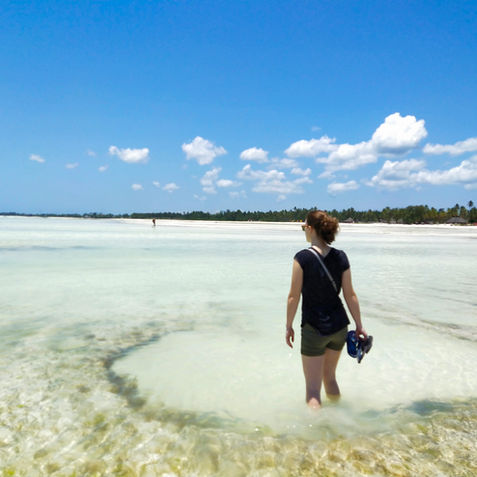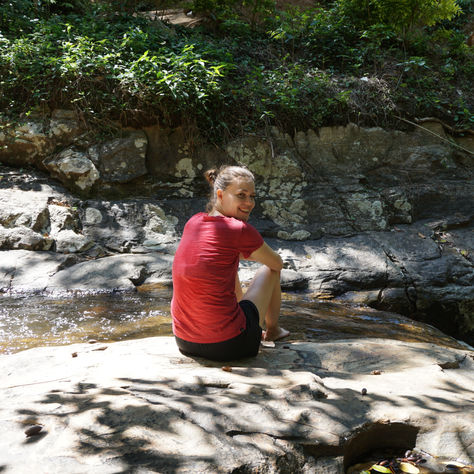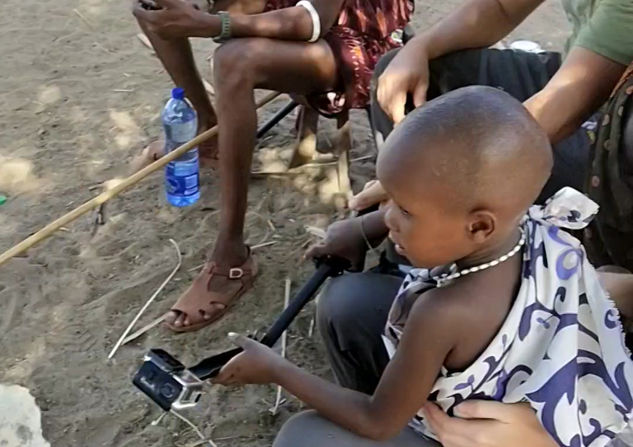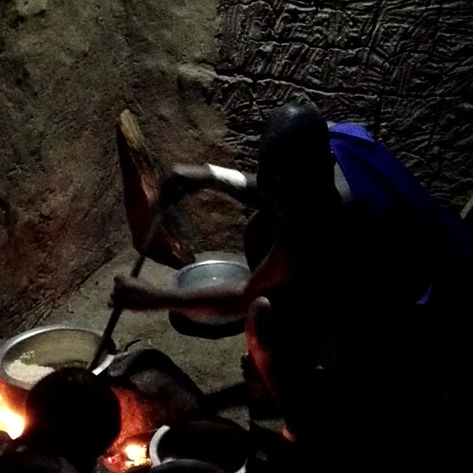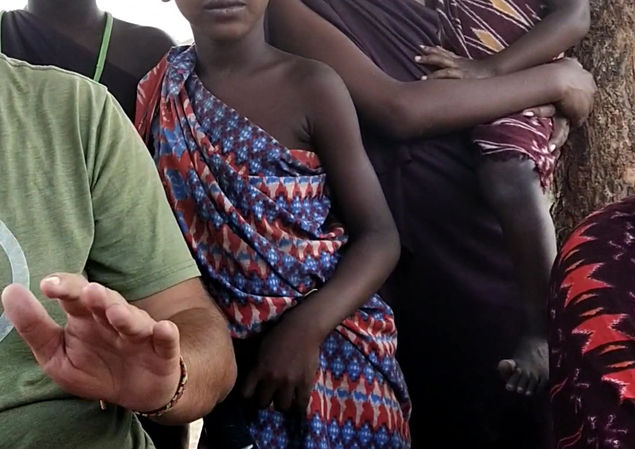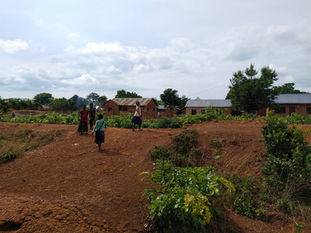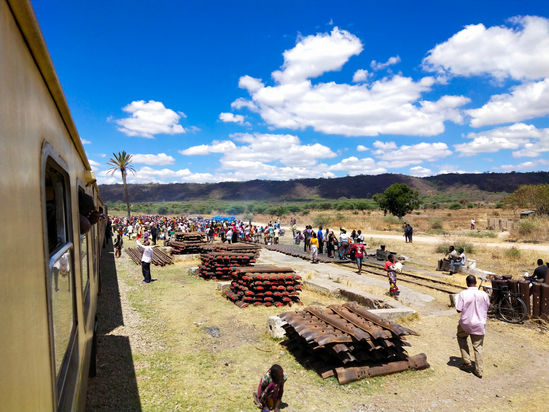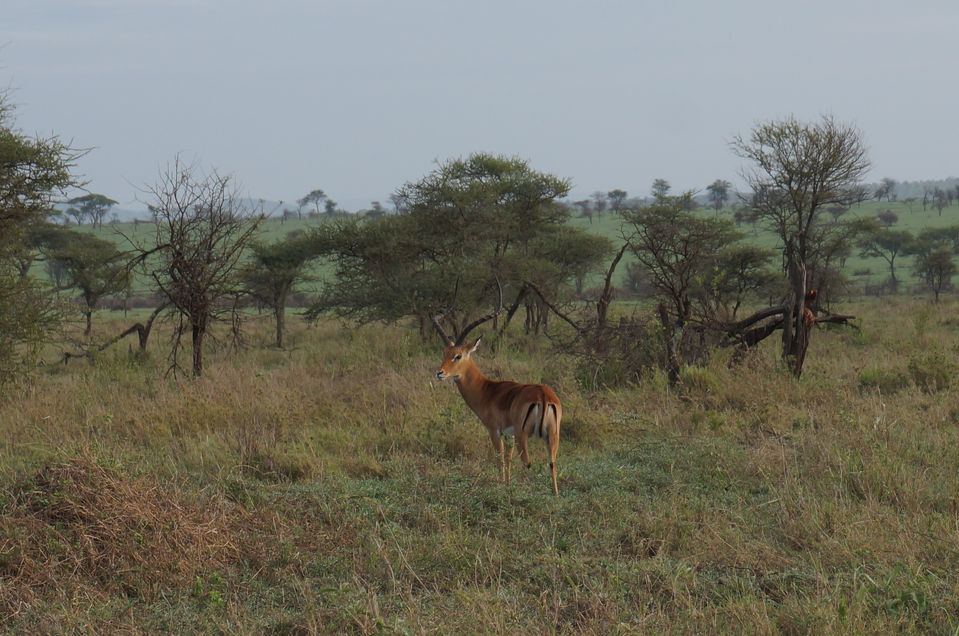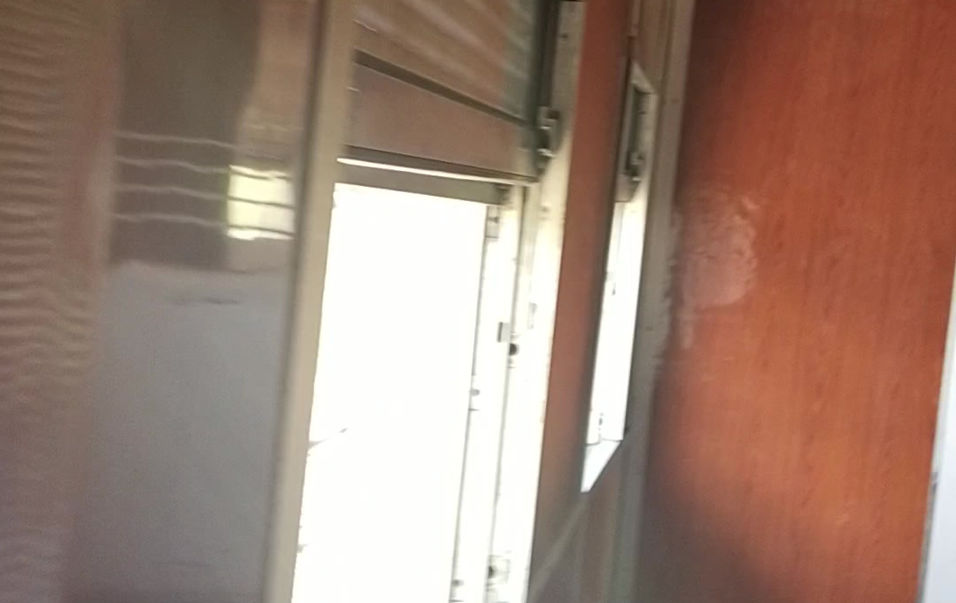
Tanzania
(15/10 - 06/12)
After more than six months of hiatus and questioning, here we are, ready for new adventures. Heading for a whole new continent: Africa. Few world travellers included it in their itinerary (prejudice, security, budget), largely preferring Asia and America. And yet, we could not imagine our trip around the world without an African touch. Because if we easily (and sometimes wrongly) associate the continent with poverty, we can quickly forget its historical, geographic, ethnic, artistic, cultural and human richness.
It is therefore natural we firstly choose Tanzania, synonymous of biodiversity, adventure and authenticity. Between moments of relaxation on the beaches of the Zanzibar archipelago, treks in the Kilimanjaro region, safaris in the largest animal reserves and meetings with populations with ancient traditions, we cannot wait to discover this country full of promises.
Contents
Zanzibar (15/10 - 22/10)
Arrival in Stone Town (Zanzibar) on the morning of October 15, after more than 25 hours of travel. Rest assured, the flight conditions were more than exemplary during this COVID period, the airline having provided us with visor, mask, gloves and hydroalcoholic gel. A little suffocating all these precautions, but we are clearly not going to complain and we measure our luck!

Our visa completed and our luggage collected, we are greeted by the manager of our future hotel (Kalfan) at the exit of the airport. Despite the fatigue, our senses are awakened and we are immediately struck by the surrounding heat, whether it is the one linked to the high air temperature or the one associated with the hospitality of our host. On the road, the latter explains to us that there is no COVID here, it stayed on the continent thanks to the island’s perpetual sun. Is that so?! On the other hand, he tells us that it will be necessary to be more careful in Dar Es Salaam, where there are a few cases... Does that mean that the weather is less favorable in the rest of the country? Weird this story... Anyway, we quickly notice that here, the mask is far from compulsory / recommended / existing... Okay. We will adapt...
After several hours of rest, it's time to... have a bite to eat of course! We are not going to lose our good habits that quickly! Well, it's already dark outside, and we must admit that we are not very reassured. We have absolutely no landmarks in this new country, whose customs and mentalities are unknown to us, and which we have often been told to be wary of. Let’s go, it’s time for our first culture shock. Verdict: not an insistent glance, no inappropriate comments, no insistence on the part of the street vendors, but only “Jambo” (Hello) or “Karibu” (Welcome) and many smiles. It is thus reassured that we enjoy our first Tanzanian meal.

We spend the next morning visiting the Old Slave Market, the town's main museum which, as its name suggests, traces the history of slavery in Zanzibar. If we knew that the island was at the time a hub of this practice, we could not suspect so much complexity.

We learn that Zanzibar was the largest slave market in East Africa in the 18th and 19th centuries. Tens of thousands of slaves lived on or passed through the island, representing more than two-thirds of the local population. Along with ivory, spices and cloves, the slave trade was very lucrative and largely stimulated by Europeans, Indians, Arabs, coastal populations and ethnic rulers of the mainland. Residents of all social classes benefited economically from slavery, which made it an integral part of the East African culture. Once their freedom was purchased, the former slaves themselves bought slaves, a symbol of wealth and domination.

Slaves (often entire families) were kidnapped across Africa before embarking on a long and perilous trek to Zanzibar. By boat or on foot, the trip could last from a few hours to several years… and many perished along the way (famine, disease, attacks, etc.). An estimated 50,000 slaves passed through Zanzibar each year. Once on the island, the captives were locked in dungeons and then auctioned off at the Stone Town market. Examined from head to toe (even including a tooth exam), their price varied according to age, gender and possible skills. Women destined for harems were the most esteemed while men in their forties were less valued. The weakest were sold in packages…

Explorers’ reports of slaves living conditions aroused an anti-slavery feeling in Britain and contributed to the birth of the Anglican Church, which made slavery one of its main struggles.
Ironically, the slave market closed in 1873 under British pressure, nation which itself initiated this system 250 years earlier. Many slaves were freed. However, slavery experienced a strong revival, going so far as to double. Indeed, the British treaties aiming at the abolition of this practice had the consequence of replacing the revenues resulting from the slave trade by the legal trade in ivory (piano keys and billiard balls), sugar and cloves. Demand for labor skyrocketed, forcing plantation owners to employ slaves, now sold illegally in private homes in addition to their regular workers.
Note that it was also very difficult for the slaves to emancipate themselves. Most often illiterate, they were unaware of their rights and had no idea of the steps to be taken (sometimes a simple letter) to obtain their freedom. Discouraged both by their masters but also by the government fearing an economic disaster, many gave up a free life that could not provide them with work, shelter or protection. Slavery in this form continued for several decades before actually declining.
We are all the more shocked when we discover that to this day in the world, between 21 and 36 million people are still victims of so-called modern slavery: forced marriage and labor (women and children), human trafficking, domestic servitude, etc. Worse still, the products resulting from this neo-slavery (cotton, cocoa, diamonds ...) enter global logistics chains to end up in our own homes (brands of textiles, food, jewelry, electronic products, cars ...), leaving most of us unaware of our contribution to this practice.


Enough to leave us speechless for a while. We continue the tour with the Anglican Christ Church Cathedral, built on the very spot where the slave market was held.

Last but not least, a memorial dedicated to the victims of slavery: a sculpture of five slaves chained by the neck with their original shackles. The monument is poignant and completes the description of the difficult conditions.

Impossible to remain indifferent in the face of so much suffering and injustice. We feel a deep but necessary emotional discharge in order to better understand the region and its past.
In addition to its unmissable slave market, the “stone city” is also a UNESCO World Heritage Site for its unique architecture. We gladly get lost in its narrow and colorful streets which make all its charm.

Between mosques and churches, colonial buildings and traditional hand-carved wooden doors, we discover the mix of Swahili, British, Portuguese, Omani and Indian influences that characterize the city. Here, the different cultures coexist perfectly and give hope ...

We then walk by the port in search of fresh air, when we see the old fort, a citadel built in 1700 by the Omanis to protect themselves from the Portuguese invasion.

Like a ritual, we do not miss our passage through the local market which for us always reflects the atmosphere and soul of the city that houses it. We are amazed by all these colors and the smells of spices.

After discussing with Kalfan, the latter offers to accompany him there that evening to taste some specialties. We gladly accept, and that's how we end up enjoying the famous Zanzibar Pizza accompanied by sugar cane and ginger juice and fresh fruits. A delight!

After three days in the island capital, it is time for us to continue the journey. Heading east and the village of Paje. We take the dala dala, common transport for Tanzanians. This is no more and no less than a (VERY fast) miniman that can accommodate up to 30 passengers despite its 20 seats. Of course, we are the only tourists on board, which makes our experience all the more authentic.

An hour's drive later, and we're dropped off at the town’s entrance. Originally a fishing village, Paje is still preserved from tourists who prefer the north of the archipelago. Good for us! We reach our accommodation on foot, feeling like we are the only travelers in the area. Even the cows are staring at us!


Along the way, the local businesses make us smile and set the tone for the next few days, like the national motto: HAKUNA MATATA (no worries).

This is the name of our superb guesthouse. For the curious, we also proceed in the same way as in Asia, namely booking our stay a few days before our arrival. Apart from a laborious WiFi connection, the infrastructure is more than adequate (spacious rooms, mosquito net, hot water, breakfast, etc.).

Our bags barely undone, we can not resist the urge to dip our feet in the water, just a few meters from our accommodation. What a blast!

To end this hectic day well, we set out to find a place to eat. And oddly, it’s not that easy. We are surprised to see many abandoned hotels and restaurants. The locals tell us that with the pandemic, a large number of establishments have had to close for lack of customers ... We will not go so far as to call Paje a ghost village, but in a few months, who knows?
After a long moment of hesitation, we dare to enter a deserted restaurant, yet very famous on the internet. Delighted, the cook hands us the menu, three times more expensive than expected. We point out to him that the prices have increased, to which he replies: hakuna matata, two for the price of one! This is how we will come back every day to taste our famous Chicken Flake, chicken and vegetables marinated in a spicy sauce.

The next day, it is a surreal landscape that we discover when we wake up. The sea receded several hundred meters, leaving a vast expanse of sand at our feet. The sun is so strong that we are unable to keep our eyes open for very long.

We walk slowly, without missing the spectacle in front of us. The ocean blue of the day before has been replaced by shades of turquoise that leave us speechless. We almost lose the notion of reality, so much that this setting reminds us of Icelandic hot springs, certain beaches of the Philippines or even a lunar scene…

However, the oppressive heat limits our days to one or two activities. Better to devote the morning to them then rest before joining our new HQ. As we approach the restaurant, we observe a colorful crowd: over a hundred people wearing T-shirts bearing the President's image are dancing and singing in his honor. We were supposed to avoid any political gathering for the next elections…. But what do we do when the gathering comes to us? No worries, the event takes place with a lot of joy.
Paje remaining a village, we quickly finish our visit, so we get to Jambiani a few kilometers to the south by foot. Would we have preferred a good old scooter to get lost on the archipelago? ABSOLUTELY. That was our original plan. Unfortunately on spot, we realize that it is not so usual to rent a two-wheeler to visit the island. Between its exorbitant price (7 times the one of Asia) and the police’s corruption, we are quickly discouraged from using this means of locomotion. So here we are, barefoot on the beach, doing the 7 kilometers that separate us from Jambiani (and no, the principle of morning activities does not always work).

Along the way, we are fortunate to be able to get close to the seaweed pickers, a difficult job created by local women to improve their lives and independence and thus rebalance equal opportunities between women and men in Zanzibar. Planting and harvesting seaweed allows them to create products (shampoos, soaps, toothpastes, etc.), earn money and therefore contribute to the well-being of their family and their community. We feel privileged to be able to photograph them.
After 2 hours of walking, we finally arrive at our destination. Well... if it doesn't make us see different landscapes, it at least makes us exercise.

Fortunately for us, the beaches of the island remain authentic: places of work for women, return from fishing for men, and above all a magnificent playground for children.


On the way back, we were even surprised to meet several Maasai. The latter, originally from the north of the country, regularly come to Zanzibar to sell their crafts to tourists. They offer to accompany us back to Paje, which allows us to discuss our respective lifestyles. Very proud of their customs, they wouldn't trade their places for anything in the world. We laugh when they tell us about the fear they felt when they first met a white person, but we laugh a little less when they try to buy me for 1,000 cows. Luckily, Anouck negotiates a giraffe and two lions, which they can't get us. It is in a spirit of sharing and surrounded by our four imposing bodyguards that we return to our guesthouse. As you can imagine, we have not gone unnoticed.


No doubt, this experience more than aroused our curiosity for our future immersion in a Maasai tribe scheduled in a few weeks.
For our last day on the island, we let ourselves be tempted by kitesurfing, an increasingly popular discipline, which links water and air sports. And what better place than Zanzibar, one of the most famous spots for this sport, to try out this activity? We learn how to handle a small kite on the beach before going to the mainsail in the water. No board this time (several extra hours required), but still some great sensations!

After a week on the archipelago, it's time to leave Zanzibar for the mainland, where our volunteer mission awaits.
Dar Es Salaam & Surroundings
(22/10 - 05/11)
For 15 days, we are an integral part of Chamazi, a disadvantaged community where children are helped in learning and extra-curricular activities. To find out more, we invite you to read the article dedicated to this unforgettable humanitarian experience here.

The weekends are free, and we take advantage of the first Saturday to go to the old capital Dar Es Salaam, about 1.5 hours away by dala dala. We arrive in the middle of the gigantic Kariakoo market, a must-see that we hasten to leave. The atmosphere is as oppressive as possible, between the stifling heat, the pollution, the excessive noise and the systematic solicitation of salespeople who grab us by the arm while whispering "sugar sugar" in our ears.
Quite the opposite of the “Havre de Paix” dreamed of when you read the name of the largest city in the country. It will take us about an hour to extricate ourselves from this labyrinth. Unfortunately for us, the rest of the visit does not enchant us more. Aside from the original and fun techniques of some street vendors, we find the city meaningless and uninteresting.

Not to mention the return trip, exactly at rush hour! That is more than two hours of overloaded dala dala vaguely reminding us something from Sri Lanka…
In short, we will have learned the lesson: Dar Es Salaam we saw it, we lived it and we will never come back!
Now that you know us, you understand that a week without an adventure is not really one... Well you are not going to be disappointed! The following weekend, we take a closer look at our passport and its Tanzanian visa. The latter, although normally valid for three months, is rarely issued by the authorities who prefer to put a shorter period on the stamp, forcing travelers to go to immigration offices to try extracting money from them…. As you can imagine, we were very careful when we arrived in order to avoid this kind of inconvenience. We were super relieved when we didn't see any expiration date. And yet... Two weeks pass quietly and here we are, rechecking our passports just like this.
Do you feel it coming...?
Out of curiosity, what do you read on our visa? Because we took more than 30 minutes to realize!

And yes, it's "TWO WEEK" (misspelled it's even funnier) so TWO WEEKS that are marked on our passports. We are considering crossing out the word “WEEK” for “MONTHS” for a while, but we finally ask our host Emmanuel for advice. Obviously, he advises us to go to the immigration office as soon as possible. A little background reminder: we are on Friday October 30 at 1 p.m. The administrative building, located more than 40 minutes by car if all goes well, closes at 2 p.m. for the entire weekend. Knowing that we landed on October 15 in Tanzania, the calculation is quickly done: QUICK!! 10 minutes walk, and Emmanuel gets us a mototaxi, the fastest way to reach our destination. It is of course three of us on the engine with our non-existent helmets that we set off. On the road, the driver feels the need to relieve himself… Of course, now is the perfect time!
First mission accomplished, since we arrive 30 minutes later. 30 minutes during which we almost died a dozen times. Driving is how to say… reckless? unconscious? extreme? In short, enough to stress us out, as if we weren't already enough! Here, no highway code, the goal is to move forward without having to stop, even if it means taking the median, overtaking on the right or the left, overtaking the opposite lane or simply slaloming between the other vehicles with 5 cm on each side. You will excuse us for not having immortalized this experience, too busy safeguarding our suspended lives.
It is 1:45 pm when we enter the immigration office. At the counter, they hardly deign to listen to us and look at us, but they do not fail to make us understand that we have to come back with a lot of extra papers. Eight photocopies later done in the front’s store, and we re-file our application, noting that we are leaving the country early December and that we need to replace the two-week visa with two months. “No problem” he tells us. We take our trouble patiently and around 3:30 p.m., we get our passports back with a new ONE MONTH visa. IS IT A JOKE? New deadline: November 29: we will have to revise our plans... It's totally empty that we leave the building to find our driver and the return trip that awaits us. Surprisingly, we come back alive and in one piece. Like Dar Es Salaam, the mototaxi we saw, we experienced it, and we will never do it again!
And then because we never have too many, we also find ourselves cut off from the outside world for several days, the government having blocked all social networks (Whatsapp, Facebook, Messenger) and several applications during the election.

Morogoro
(05/11 - 07/11)
After two weeks of volunteering, we head to the mountainous region of Morogoro where a beautiful program is awaiting us. Five hours on the bus later and an additional traveling companion (our Canadian friend Ian who will be with us for a bit), and here we are, the three of us squeezed in a tuk-tuk heading to Oldonyo Mountain View. As its name suggests, this guesthouse is located on the mountainside and overlooks the entire city. We are welcomed by Fanny & Ibrahim (Ibra), a Franco-Maasai couple, and their two children (William 6 years old & Moïra 2 years old). Met during a solidarity project in Zanzibar in 2013, they decide to settle down together and develop the crazy project of opening a guesthouse. The latter was created in 2018, after two years of work (without electricity) and administrative procedures. The result is worthy of the efforts made: a magnificent house with views over the entire region and an ideal spot to admire the sunset.




Over the course of the meal, Ibra enjoys telling us one of his favorite stories: the first time he got on a plane. We take the opportunity to ask him questions about the customs of his village, which he visits whenever he can to recharge his batteries.
The next day, we equip ourselves for a trek in the heart of the Uluguru Mountains, home to some of the oldest forests in Africa. We are expected by our Maasai guide Samuel with whom we will spend the day. From the first minutes of hiking, we are surprised by the biodiversity of the surroundings, both in terms of fauna and flora.

The walking is pleasant as the climate is mild, which is ideal for the agriculture widely practiced in the region.
After 2h30 ascent, we reach our first destination for lunch: the Morning Side. It is an old building dating from the German colonization, more than 100 years old. It is not really maintained, but the interest of going there lies especially in the superb panoramic view that one has from the site, over the whole town of Morogoro and the agricultural lands of the Uluguru Mountains.

In the afternoon, we follow small paths (sometimes steep) and cross many villages in an impressive setting.

We take advantage of the Choma Waterfalls to rest a little and refresh our sore feet. The waterfall is a nice surprise that we did not expect.


After 7 hours of trekking and breathtaking landscapes, it's time to return and prepare for a memorable experience: an immersion in a Maasai tribe.
Parakuyo Maasai Village
(07/11 - 08/11)
In the morning, we leave for Parakuyo, the Maasai village where Ibra is from. We plan to spend the weekend there with him to learn more about the culture of this famous tribe. The Maasai are warriors and semi-nomadic people of Kenya and Tanzania. Initially nomadic, they used to migrate regularly and move freely across borders depending on the seasons and the resources available for their livestock, their greatest wealth. Established for the most in large animal parks, the government has however been trying for several years to relocate them and settle them in order to further develop safaris and other tourist attractions. These attempts resulted in the impoverishment of the Maasai population, with many young warriors preferring to turn to a more Western lifestyle and a higher education. Now, the Maasai are trying as best as they can to find their place between their well-established culture and the demands imposed by a changing world. Each tribe is therefore different, despite a very different way of life than ours.
We feel very privileged to meet this ancestral ethnic group and to immerse ourselves in their threatened environment. After a 1h30 drive from Morogoro, we go deep into the bush and discover the village of Parakuyo. Obviously, we are welcomed by many children delighted to be able to exchange with strangers.



The Maasai people have kept a traditional way of life in harmony with nature allowing them to live in (almost) self-sufficiency. Almost, because as indicated above, they have learned to deal with the ingredients, sometimes imposed, sometimes welcomed, of a modern world. We quickly get to understand the functioning of the village of Parakuyo: a large village (under the authority of a chief) spread over tens of kilometers, with solid central buildings (church, essentials store, school) and dwellings. The Maasai thus live in a dispersed habitat in these mini-villages called bomas. They are made up of small houses built from intersecting branches covered with cow dung and dried mud. The huts are generally divided into several rooms dedicated to the guests, to the kitchen, to the animals, and to a sleeping area distinguished by a cowhide drawn on a wooden plank.

Each boma represents a family, made up of a man, several women and many children. Indeed, polygamy holds an important place in the Maasai culture. Not having the same emotional connection as us, it is inconceivable for a Maasai warrior to have only one wife. It is therefore normal for a man to have ten wives (or even thirty!) And fifty children !! In contrast, a woman can only get married once. However, we learn that extra-marital relationships are common (with a brother-in-law for example). In short, we must admit that our Western mentalities have a little trouble getting it, especially when we see women scampering off when their husbands arrive, as they fear of being beaten... Each house is reserved for a woman and her children, the husband changing his house as he pleases... The good thing is that there is no jealousy, with women even encouraging their men to multiply wives in order to have more girlfriends and support in the tasks.

The dwellings are generally deprived of water and electricity, forcing the Maasai to settle near a lake or a river. However, the government, in its intention to limit this nomadism, is now installing solar panels and water collection systems in the ground.

As soon as we arrived, we were involved in the lunch prep: national ugali (a kind of polenta made from corn) accompanied by a sauce made from tomatoes, potatoes and fresh milk. Of course, everything is eaten with the hands!



The Maasai people feed mainly on milk and blood, which they can take from the necks of young cattle without killing them. Blood associated with milk is the staple food (thank goodness we escaped it!). Meat is rarely consumed and reserved for special occasions.




While the Maasai all have their heads shaved for maintenance, men and women adorn themselves with jewelry from head to toe, with body ornamentation playing an essential role in their customs. From the age of 12, young girls learn to put on pearls (necklaces, bracelets, cuffs, belts) and to embroider multicolored clothes.


The children are a little perplexed in front of our long hair and sparkling jewels…



They are also very curious about our electronic devices and are very excited to discover themselves inside a strange box.

But what fascinates them the most is of course our white skin, which they never get tired of touching and rubbing.


The Maasai are divided into patrilineal clans and age groups: children, young warriors, adult warriors, young elders and elders. Each passage from one stage to another is accompanied by initiation rites: circumcision for young boys, excision for young girls (although illegal), the handling of weapons, war songs and traditional dances, etc. The younger ones greatly admire the older ones and bow to them as a sign of respect. The elders then touch their heads to greet them.


During our visit to the surrounding bomas, we notice many cows and goats. Not surprising, since the entire life of the Maasai revolves around cattle, their main source of food (milk and meat) and wealth (in order to ensure a small income as well as as a dowry at marriage). The prestige of a Maasai is measured by the size of his herd. Without his cattle, he is nothing.

In the morning, the men take their herds to graze for the day (sometimes several days) and return to the village at sunset to allow the women to milk them and possibly take care of them.

Therefore, it is true that we did not see many Maasai men during our immersion. On the contrary, we were left speechless at the amount of work done by women. The latter are responsible for the construction of the huts, the search for water and wood, the manufacture of jewelry, the creation of clothes, the education of children, the cooking, the maintenance of the village and the care of animals on site. Beyond the cattle, the men are responsible for going to the market and ensuring the safety of the boma. The most difficult task, however, is for the elders: to gossip in the shade of the tree all day long. As you understand, equality between men and women among Maasai is far away from what we know.

Girls and boys alike, children are also called upon very young.


Each individual in the tribe has a definite place and knows what to do. Naturally, we all get to plan the dinner together. The task: sorting out rice grains and cooking over a wood fire in an extremely warm atmosphere. We feel a real community spirit and we feel so welcome by these ladies.

It is with the headlamp (a revolution for them) that we enjoy our delicious meal.

Then comes the time to clean up. A bucket of cold water behind the hut. That’s it. For the toilets, it is in the bush, but not too far because we would prefer to avoid coming face to face with a hyena or a lion. Well refreshed, it's time to discover our little nest! Security level, don't worry, the entrance is well guarded!

Let it be said, the night is harsh. Between the nonexistent mattress, the stifling heat, the dozen hens under our bed and the incessant sounds of animals, we barely close our eyes.
We are almost elated when we get out of bed at 6 a.m. And what better way to start the day than a chicken attack?
After breakfast we spend some time with the children. They are entertained by nothing, and we are having fun sharing these moments with them.

Of course, Anouck discovers a new passion for goats.

We are then invited to Sunday celebrations. We don't mind when women offer to dress us as Maasai, happy to be able to make them proud and show them that we want to adapt. Well, let's face it, we've already felt more ourselves in other clothes, but now is the time to have a good laugh!

We go to the village church and attend the weekly mass. Between the pastor's sermons, songs and dances, we discover a different and a little more cheerful way of praying.
We end with a handshake with ALL of the participants. Right thing to do during these times of pandemic and confinement ...
After a day and a half of a very intense immersion, our experience comes to an end. It is not without emotions that we say goodbye to the village and its inhabitants. And while it is true that we do not always share the same convictions, we keep an indelible memory of our Maasai stay, between responsibilities and carelessness, freedom and seriousness, but always imbued with simplicity and authenticity.


Kigoma & Gombe National Park
(08/11 - 15/11)
Still struggling to recover from this timeless Maasai escape and yet it is already time to move on to the next adventure. From reading the many comments from travelers, we already know that it will not be easy. Our objective is as follows: to reach Kigoma, on the border with the Democratic Republic of Congo, by train. That is 1060 kilometers and 35 hours of travel. However, it is better to plan for twice as much, delays and breakdowns being frequent. Sounds promising, isn’t it?
After 1 hour of negotiations with the station master and several telephone conversations, we finally manage to book our first class tickets (2 beds cabin) for Sunday evening. Just enough time to take a good shower and a good meal after our Maasai immersion before joining the quay and already the hundred or so passengers on site.
Obviously, the train arrives two and a half hours late, so it's at almost midnight that we reach our new quarters that are... already occupied, of course!
It will take another 30 minutes for a manager to free our seats so we can get settled. For sure, in terms of cleanliness and safety, we've known better! The pieces of wood are used to block the windows to prevent any nighttime intrusion, the sink is infested with cockroaches and the fan does not work. A delight!

The noise is simply deafening, and we quickly understand that it will be difficult to fall asleep (so to change...).
We particularly appreciate the moment when the train has to hang up the wagons, resulting in a dozen collisions and in the process Anouck's fall when brushing her teeth. More fear than harm!
Fortunately, the rest of the trip goes smoothly, and we do not regret living this travel step like locals.
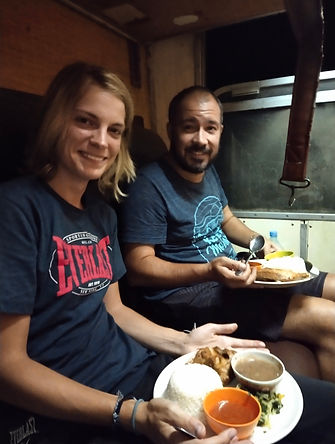

We enjoy the landscapes and are surprised by so much diversity!

Our favorite moments are still the stops on the track where many salespeople come to the window to do their business. We never get tired of their reaction at the sight of three strangers: “MZUNGUS MZUNGUS” (white people) while pointing at us.

After 37 hours of travel, we finally arrive at our destination, and although we are delighted with this experience, we cannot wait to be able to properly recover from the last few days in a real bed and take a hot shower!
While it is true that we do not go on forever in visiting Kigoma, the region does come as a surprise. Surrounded by mountains, it is home to many fishing villages as it is located on the shores of Lake Tanganyika, the largest freshwater lake in the world and the second in terms of depth.
As far as we are concerned, we are busy organizing our excursion to Gombe National Park, the cradle of much of the research done by the primatologist Jane Goodall in the 1960s on the behavior of chimpanzees. Located 16 kilometers from Kigoma, the park is only accessible by boat and therefore requires some upstream preparation. To say we're excited is an understatement!
A day of logistics later, and here we are aboard our boat. Direction Gombe National Park and its hundred chimpanzees.




During the two hour crossing, we see several isolated dwellings and fishermen in action. We wonder how they manage not to capsize in such small boats!

As we get closer to our destination, the vegetation becomes more lush and the baboons are more numerous on the shore of the lake.



Late morning, we finally reach our goal.

We just have time to sit down and eat our lunch, and it's already time to meet our guides for the day. They explain that the animal park serves as a habitat for a very diverse fauna, including many primates such as baboons, colobus monkeys, blue monkeys and of course chimpanzees, which are still the subject of in-depth research today. After having assimilated the rules of good conduct (compulsory mask and contact prohibited to avoid any mutual transmission of disease, limitation of one hour of observation so as not to disturb them), we are heading to our chimps tracking!

We have been hiking for about an hour and a half when our tracker communicates the position of a group of chimpanzees via walkie talkie to our guides. We are very close! A few minutes later, we finally find them. In front of our eyes, about twenty chimpanzees.

Apparently, it's mealtime: between foliage, various fruits and insects, the primates seem to be enjoying themselves!

Like Jane Goodall several years earlier, we are amazed to discover the ability of chimpanzees to make tools for food. They start by removing the leaves from a twig of a certain size which they then insert into the termite mound. After a while, they remove the small branch on which are hanging several termites, which they are eager to taste.
We also learn that they can crack nuts with the help of carefully chosen stones and that they are used to hunting. Their opposable thumb allows them to grasp objects and use tools.

After several minutes, the group seems to have had enough and decides to move. Chimpanzees indeed live in communities (up to 100 individuals). During the day, they split up into smaller groups to go look for food in the forest and then meet in the evening for the night.
We follow the group and try to keep the pace. Not easy, because they are very agile and move quickly while we have to make our way through the jungle (you can imagine that the chimpanzees do not use the regular path!).

We arrive on a second termite mound, where the chimpanzees repeat their favorite activity. Some even strain their ears to better locate insects.

We are quite impressed by the calm and the concentration they show in order to achieve their goal.




We also notice how easily the transmission of knowledge from one chimpanzee to another is done. The whole group can participate in the education of the little ones. They observe the older ones doing and repeat the exercise. After several tries, they get there without any problem!

But not too long, because we shouldn't forget to have fun! Small chimpanzees play a lot: they tickle each other, fight nicely and even play hide and seek (yes yes!).


This chimpanzee looks very dreamy. While we cannot know exactly how many years old he is, we can quickly guess it from his gray beard.

We end our hour of observation with a mother and her little one very accomplices.
We return to the camp very satisfied, without suspecting that the day was far from over... After the coldest of Tanzanian showers, we are quietly lying in our room to sort out our last pictures when our door suddenly opens. We risk it with a "Hello", believing it’s an employee's mistake. No, it’s not! I discover with terror a baboon at the foot of the bed. It takes Anouck a few seconds to believe me, just enough time for a huge male baboon to creep into the room. We are as shocked as they are when we come face to face. Neither one nor two, we climb onto the bed and use a blanket as a shield, having no idea how to behave. The monkeys, on the other hand, make themselves at home: they inspect all our things and throw on the ground what does not interest them. Only our case, which they brandish like a weapon, seems to attract their curiosity. We call for help without shouting for fear of upsetting them. Anouck is amused while I am totally petrified. It’s only after long minutes that a guard comes to our help and chases the baboons away with a broom, reminding us that we must lock our quarters securely. No worries, we'll remember that! Too upset by this eruption, we did not have the reflex to capture this memorable moment, but we share with you the photo of a baboon strangely resembling THE ONE.

We come back to reality as best we can in front of a magnificent sunset on Lake Tanganyika.

After a good night's sleep (and three turns of the key), we set off on a trek on the morning. This time, it doesn't take more than half an hour to see our first chimps. The latter are comfortably installed on their high nests that they make every evening for the night and which protect themselves from predators and rain.

We then witness a real concert indicating that it is time for them to get going. Chimpanzees communicate with each other at a distance and thus exchange information through more or less strident cries.
Too fast for us, we follow a mother and her little one who move in slow motion. A female gives birth to a young (sometimes twins) after 8.5 months of gestation. She carries it hanging from her belly for about 6 months until the baby becomes more mobile. The little one then rides on her mother’s back until he is 4 years old.

As breastfeeding continues throughout this period, baby chimpanzees most often remain stuck to their mothers. Even after their teenage years (around 10 years old) and their transition to adulthood (12 to 15 years old), chimpanzees retain very strong bonds with their mothers.
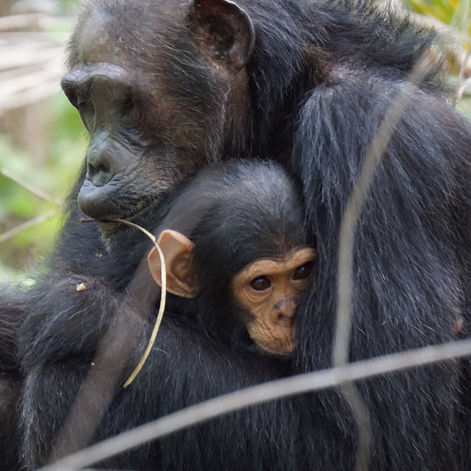
The mother and her baby lead us to a huge tree, probably a meeting point for primates, since we see about twenty other chimpanzees arriving. They scream, swing, jump from branch to branch, until Anouck gets one on the head!


We remain cautious and we do not forget that a chimpanzee remains a wild and potentially dangerous animal, with three to five times the strength of a human!

Then comes the quietness and the grooming session, a practice very common among monkeys. Beyond removing small parasites, this activity represents a mark of affection and comfort.

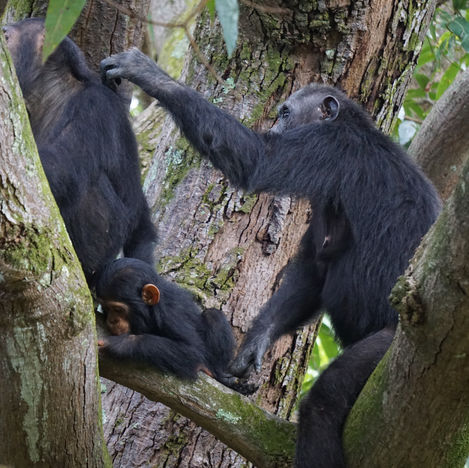
We end softly our trek before returning to the camp.

We have barely returned that the rain invites itself to the party, forcing us to hurry back to the boat to head back to Kigoma. On the way, we find it hard to believe that these animals so close to us (they share 98% of our genes!) are in danger. Between the bushmeat and pet trade, deforestation and disease, chimpanzees are now on the verge of extinction. Their slow reproduction (an average of four children per female) makes them all the more vulnerable to all of these threats. However, monkeys play an essential role in the protection of our ecosystem (consumption of fruits and significant movements contributing to the regeneration of forests, lifespan of 50 years). Protect them!
The sky is clouding over and our trip on the lake turns into a race against the clock to avoid the storm. We finish just on time, since the flood comes as soon as we set foot on the ground. What an adventure!




Arusha, Safari & Mount Meru
(15/11 - 29/11)
The next morning, we continue with a 20 hours bus ride to Arusha, at the north of the country. Unlike in Asia, overnight journeys are prohibited here, causing us to waste a lot of time in transport, which suddenly seems longer. To our astonishment, we arrive at our destination alive and almost on time! The city of Arusha is of little interest in itself, except for its advantageous location halfway between national parks dedicated to safaris and mountain treks. Fortunately, a few stalls make us smile amid the many requests from tour operators, ready on every street corner.

We thus manage to organize our safari without great difficulty. We pick on a combined 3 days/3 nights tour in the famous parks of Serengeti and Ngorongoro. In order to get in the mood, we spend our first night on the shores of Lake Manyara in a wild setting.

We take the road the next morning to the animal reserves. The weather is catastrophic, and we wonder for a moment if our lucky star is not gone. Fortunately, after three hours of driving in the pouring rain, the sun is showing its nose at the park’s entrance, as a sign of welcome.

Here we are in the Serengeti National Park, in other words the safari paradise. Indeed, a UNESCO World Heritage Site, the Serengeti is home to more than three million animals and spans over 15,000km², hence its original Maasai name meaning "endless plain". We quickly understand why…

Immediately, we are teleported in an animal documentary in the middle of hundreds of zebras, wildebeest and antelopes. We are actually witnessing the Great Migration, right in front of our eyes, the most impressive spectacle offered by nature and for which the park is famous. Each year at the same time, endless herds of herbivores (including two million wildebeest and 500,000 zebras!) travel thousands of kilometers in search of new pastures and water points. Considered one of the Seven Wonders of Africa, the great migration knows no borders and is the biggest migratory phenomenon in the world!

The beautiful surprises follow one another and we come face to face with a giraffe. We are amazed, both by its size (4 to 6 meters) and by its gait which gives the impression of a film in slow motion.

Then it's time for the hyena horde. We seem to interrupt them in the middle of a nap, or rather in the middle of their digestion if we are to believe the good piece of zebra in the middle of their circle.

Luck is clearly on our side because a few kilometers further we see six lionesses and a lion resting quietly. The male is shy but we manage to immortalize the felines easily.

And as if we don’t have enough, at the end of the day we see two cheetahs. With a top speed of 110km/h, it is the fastest land animal in the world. Unfortunately not fast enough to escape humans, as he is threatened with extinction. What a look!

Besides the wild animals, a safari is also synonymous with adventure in a breathtaking environment. The Serengeti is no exception to the rule and offers a wide variety of stunning landscapes!

For the night, it's CAMPING! Anouck is delighted, me a little less, especially when we are told that the camp is not protected and that it is common for lions and hyenas to roam around the tents at night. We prefer not to think about it for now and enjoy the evening.

Strangely, Anouck’s motivation takes a hit at the sight of the thousands of insects in the toilets! She prefers the bush, and too bad for predators!
Speaking of predators, of course we heard the sneering hyenas at nightfall, not to mention the lion who visited us at 2:30 am! With her earplugs, Anouck (again) didn't want to believe me, and it took confirmation from our driver the next day to convince her. Believe me, a purr like a few inches from me cannot be forgotten, and we hold back without any problem going to the bathroom! Besides, isn't it an African marabout that we see when we brush our teeth?

Early departure for our “game drive” (jeep safari) at 7 am, the animals are more likely to be seen before the heat of the day. Winning bet, since we quickly meet zebras, impalas, buffalos, monkeys and gazelles, among others.
A disgusting smell then announces the proximity of hippos, and it is indeed dozens of mammals that we see basking in the muddy water. Although they are herbivores and fans of jacuzzi sessions, it is best to beware of this unpredictable and aggressive animal responsible for many attacks in Africa.

We barely have time to turn our heads when a new horde of hyenas moves a few feet away from us. You could almost touch them if they weren't so repulsive!

We spend our last hour of treasure hunts in the middle of a procession of migrating wildebeests. The decor is amazing and looks a bit like Jurassic Park! How lucky we are to witness this unique phenomenon!

The absence of big cats and elephants leaves us a little hungry, but we do not give up hope for the rest of the safari. For now, we prefer to pretend being mechanics in order to change the completely flat wheel of our jeep in the middle of the savannah. Only the lions are missing!
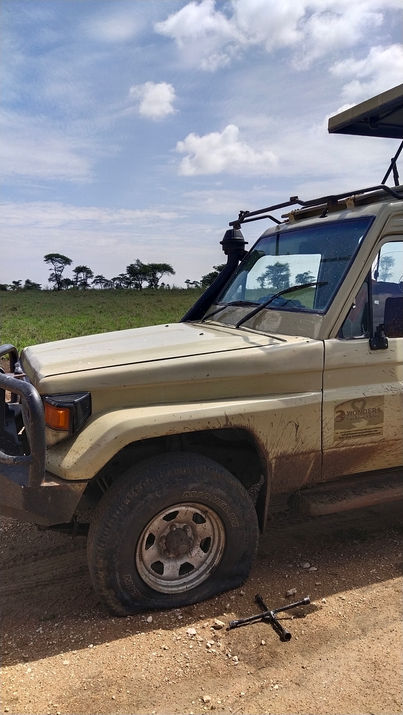
The Serengeti is over, and we might regret not spending more time there. But with a limited budget, we have to make choices and this is how we head to the second most popular wildlife reserve in the country: the Ngorongoro Conservation Area. The journey again offers us magnificent panoramas.

We also come across many Maasai villages which remind us of our immersion in this community. Unlike the Serengeti from which they were expelled, the Maasai are allowed to remain in their ancestral lands of Ngorongoro provided they maintain their traditional way of life.

The vegetation changes as we get closer to our destination, and we even have the opportunity to observe several giraffes feeding themselves.
Highlight of the spectacle a few minutes from the end: a gigantic elephant of about fifty years old (according to our guide) with its two impressive tusks. We are simply captivated.


So it's all excited and totally re-motivated that we reach our second camp. And what a location! Beyond the more than appreciable hot shower, we pitch the tent in a peaceful and relaxing setting.


This time, Anouck does not take the risk of missing night visitors and does not miss the zebras that come to graze a few meters away. More wild, you die!
New morning wake-up call for a game drive in the spectacular Ngorongoro crater, another wonder of the continent. It is the largest intact caldera in the world and is home to the largest concentration of wild animals in Africa. Good start of the day!


After more than 600m of descent, we reach the bottom of the crater and immediately notice the richness of the surrounding ecosystem. The animals seem less fearful, more accustomed to humans due to the Maasai presence, and can be approached very closely.

We approach the edge of a forest and discern two massive buffalos against the light on the verge. The guide tells us that the African buffalo is the most dangerous animal on the continent! Yet they seem so calm...

Change of scenery and we are propelled into a small tropical forest. Surprise, an elephant just precedes us, blocking our way.

We follow him with our eyes for a few seconds until we realize he is joining his herd of at least FIFTY other pachyderms. The photos speak for themselves.


Apparently it's Elephant Day, as we barely leave them that we meet another herd of the same size! We who were afraid of not seeing one of Africa's most emblematic animals, here we are!


We leave the woods to find the meadow and its wildlife: birds, ostriches, buffalos, hippos, hyenas and warthogs among others.

Once again, the landscapes do not leave us indifferent.
We decide to stop near a beautiful setting, just to enjoy the last moments.

On the way back, we see a rhino from afar, camouflaged in the tall grass. And although it is impossible for us to photograph it, we feel privileged to be able to observe this endangered species. After 4 hours on the road, the safari adventure comes to an end, and if it is true that we were looking out for even more animals (felines in particular), we remain delighted with this absolutely essential experience of the continent and the country.


Don't think of a safari as a chilling experience. Between the long transport times, the noise, the constant shaking and the nights absolutely not restful, we need a full day to recover. Just what it takes to prepare for our next expedition, and not the least, the ascent of Mount Meru.
Tanzania has many mountains, so we could not imagine our discovery of the country without an ascent to one of its peaks. If the Kilimanjaro culminates at 5895m and makes us hesitate a lot, we finally discards the highest mountain in Africa in favor of its little brother Mount Meru at 4566m.

To do this, we are accompanied by a great team from SD Safaris: our experienced guide Hassan, our cook Johnny, as well as our three porters Salim, Bilal and Christopher. We have a little trouble understanding the need for so many porters, but in addition to transferring clients' belongings, we learn that they also need to carry sleeping bags, food, stove and gas (yes yes!). So, we try to minimize our stuff as much as possible to avoid overloading them.
Once our bags packed, our team picks us up, and we head to Arusha National Park and Momella Gate, the starting point of the climb. We pick up our ranger Ozi there and set off without any delay.

The trek takes place over three days and two nights and is divided as follows:
DAY 1: Momella Gate (1500m) - Miriakamba Hut (2500m)
The first part of the ascent looks more like a safari on foot (and this is not to displease us) because we have the chance to meet several antelopes, buffaloes, zebras, monkeys (columbus, blue, baboons), without forgetting a tête-à-tête with a solitary giraffe!

We then walk through many forests, feeling like we have entered The Jungle Book.

The most impressive remains the Fig Tree Arch, a gigantic strangling fig tree naturally shaped into an arch capable of letting vehicles pass.



We always follow our ranger Ozi closely, especially when he announces our arrival in a python territory or when he spots two buffalos ready to attack us, forcing us to deviate from our way.
The views multiply and give us a good overview of the Arusha region and its national park.

After 4h30 of hiking, we arrive at our first camp located at an altitude of 2500m. We are quite surprised by the comfort: rooms with bunk beds, sanitary facilities (with cold water of course) and a dining room.


We do not miss our first sunset on the mountains and its orange colors, while trying to discern the Kilimanjaro, which likes to hide.

The results of this first day are very positive, even if it was difficult to understand the interest of our guide since it is the ranger who leads the dance. The legs and feet are ok, the head too, and we tell ourselves that so far, we are not doing so badly! Hope it lasts...
DAY 2: Miriakamba Hut (2500m) - Saddle Hut (3500m) and acclimatization at Little Meru (3820m)
Departure at 8 am above the clouds with Mount Kilimanjaro at the back, this time well clear. It’s hard to believe that by this time other trekkers have reached its summit!



The vegetation changes rapidly, and the forest gives way to a scrubland worthy of Provence, plus the altitude.



We arrive at the second camp without too much difficulty after 4 hours of ascent.


But it’s barely rested that we have to put on our hiking shoes. Heading to Little Meru at 3820m to acclimatize.



45 minutes later, and we reach our goal and its extraordinary 360° view. This is when we really realize what lies ahead ...

We quickly descend to the camp for a more than basic shower and a hasty dinner. We enjoy our last sunset at altitude (colder, let’s admit it).


It is a little less than 8 p.m. when we go to bed, determined to recover as much as possible before waking up in 4 HOURS !!
Relatively easy second day then, but we understand that the accumulation of kilometers and lack of sleep will clearly be felt. To be continued ...
DAY 3: Suddle Hut (3500m) - Mont Meru (4566m) & descent to Momella Gate (1500m)
Midnight, the alarm rings, and there it hurts, very badly! It is pitch black, very cold, the legs are heavy and the eyelids even more! We console ourselves a little with tea and cookies, then take the road to the top.
For this final stage, no ranger, and we necessarily better understand the usefulness of our guide who leads the way and sets the pace. We are also supervised by our porters Salim and Bilal to ensure our safety. A word of advice: don't bundle up in your five layers of clothing from the start, you will quickly die of heat!
In the light of our headlamps, we follow the bush path and safely reach Rhino Point at 3800m.
So far all is well, until then ... The trek suddenly thickens and turns into a cliff that we have to walk around with the help of chains. Fortunately, Hassan, Salim and Bilal are there to reassure us, but at almost 4000m in the dark and the precipice a few centimeters away, believe us, we are not showing off! You should have told us to bring the rock climbing equipment!
The rest of the ascent takes place over volcanic terrain between ash and rocks for more than three hours. This is where the altitude begins to be felt. Between cold, fatigue and long breaks to avoid freezing, our physical reserves are dangerously depleted. So much so that we start being dizzy and we have to take a few minutes to rest. On the verge of fainting, hot ginger tea prepared by our team is welcome, as are our dextrose tablets which put us back on our feet. But it is above all, the sight of the sun that points the tip of his nose, synonymous with near arrival, that soothes our hearts.

Almost arrived, well... We think we are almost done when we come up face to face with a big rock wall to climb, several tens of meters high. And so it is with the Tanzanian flag in sight, gritted teeth and wet eyes that we painfully reach the top. IT IS DONE! Here is Mount Meru, 4,566 meters, the second highest mountain in the country and fifth in Africa.



We are moved as we realize what we’ve done and watch the sunrise over Kilimanjaro in front of us.


Time is suspended, and we are gradually measuring the force of nature and its elements.


We stay at the top for about 30 minutes, just enough to enjoy this unforgettable moment and immortalize it in the company of our most loyal supporters.


And if we dreaded the climb, know that we clearly underestimated the descent! The legs are shaking, the knees are aching, the sun is beating down, in short, it's endless. But at once, we fully understand why the climb is done at night: apart from the lower temperature, NOBODY could climb Mount Meru being fully aware of the danger and the height difference perfectly visible in the middle of the day.



In the end, it will take us a little over three hours (compared to two planned) to reach the Suddle Hut. An hour, time to eat soup and get our things ready, and it is already time to leave for the first camp, that is to say three more hours of descent. It’s exhausted and at the edge that we’re doing it. The rest of the journey is by jeep to Arusha, where we warmly thank all of our team without whom we could never have surpassed ourselves that much.
And as expected, it takes three days for us to recover, both physically and mentally. That's good, since we have to carry out a COVID test for our border crossing to Zambia in a week. Here it is, $75, and obviously not reimbursed, but we prefer to laugh at the absurdity of the situation (since the virus does not exist in the country ... why a mandatory test to leave it?). Let's continue.
Lushoto (29/11 - 01/12)
It's time for us to say goodbye to Arusha and all the adventures the region had in store for us, heading to Lushoto and the Usambara mountains. The bus driver looks confident, and fortunately, as the 8th and final hour of the journey is on a winding cliff-side road.
We arrive safe and sound, and are greeted by heavy rain forcing us to take shelter. As best as we can, we try to protect our bags, but it is a waste of time for our completely soaked shoes and clothes!

Fortunately the next day, we get up with a beautiful blue sky. We hasten to spread all our things in the sun and go for a little hike. Yes yes, we don't have enough! Rest assured, no big peak to climb, but magnificent villages to cross.

A big thank you to Google Maps, very useful since the start of the trip, because here zero signposts and several homemade roads.


After an hour's walk, our efforts are rewarded with a fantastic view of the region and the horizon. We perch on a huge rock in order to appreciate the panorama and the restful reigning atmosphere.
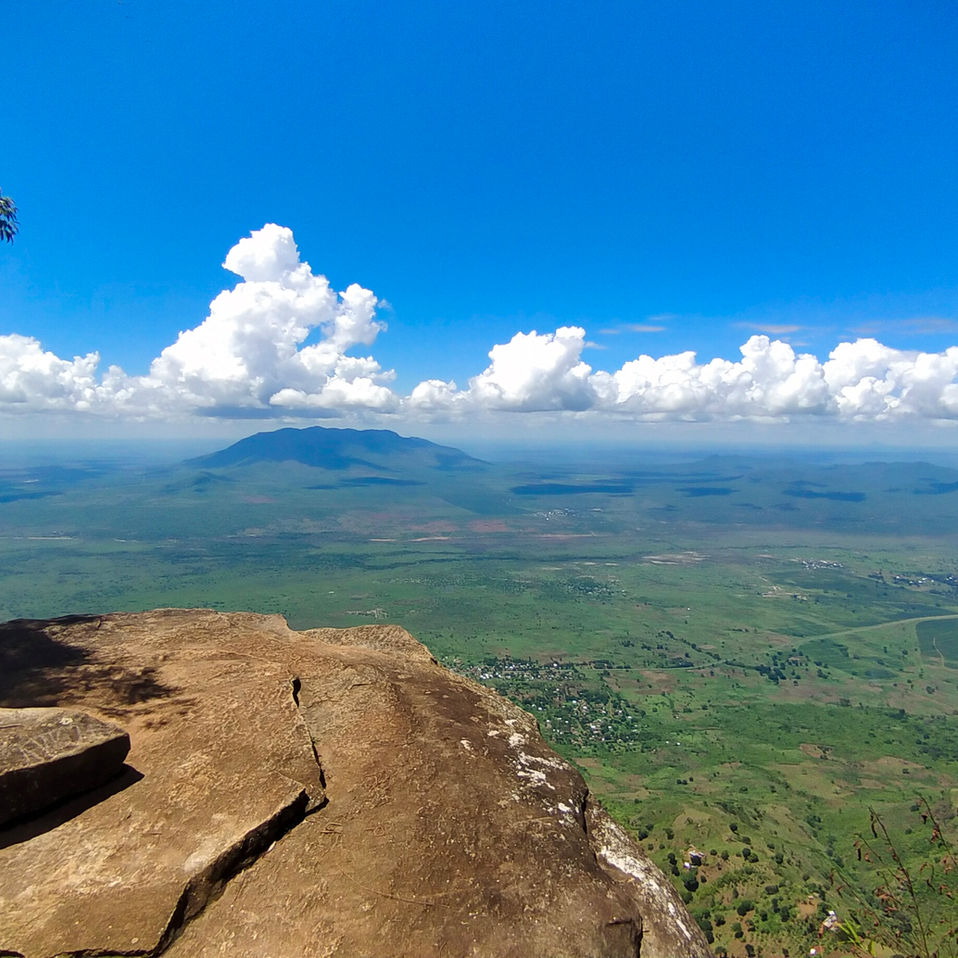
We are very happy to have included Lushoto and its surroundings in our itinerary, because even if our passage there is of short duration, it allows us to recharge the batteries a bit before resuming the road towards the capital, and this within a colorful and rejuvenating framework.
Road to Zambia
(01/12 - 07/12)
After three days of waiting (and blogging) in Dar Es Salaam, we finally make our way to the station to catch our train to Mbeya on the border with Zambia. Oh, the train is cancelled !! We are checking with other travelers who tell us that the departure is postponed until tomorrow. A first for us! But then, what are these people waiting for? Well, they are sleeping there. If we are told that the place is safe, we are still recommended to stay in a hotel overnight in order to avoid all the mosquitoes at the station that can give us malaria. Okay, if you insist!
A good night in a hotel, and we return to the station the next day, hoping this time it will work for good. We only have a few days left on the visa…
Luckily, the train arrives at the station only two hours late, so 25 in total! It doesn't seem to bother anyone, but we have to tell you that after two months in Tanzania, the lack of organization and catastrophic time management are starting to be felt.

At least we are sure that we get to the border on time. The trip is much smoother than our last experience on rails, despite the usual jolts and our slightly crowded compartment.
We arrive in Mbeya the next day at the end of the afternoon and spend the night there. Then it's time to head to Zambia. 15 minutes of tuk-tuk and 2h30 in an overcrowded dala dala, and we are dropped off at the Tunduma border post.


Armed with our passports, negative covid tests, yellow fever vaccination cards and our visa dollars, we walk confident but stressed towards the authorities. Obviously, what had to happen happens. We are refused our tests on the pretext that they are not recent enough: 8 days instead of 7 (of course). We try to explain ourselves by showing the official online sites indicating that the test should not be more than 14 days old but nothing helps. They want to retest us. No way, they don’t even wear a mask. We calm down, we apologize, and after an hour of talks, we are finally let through. Exit stamp, followed by the Zambia entry stamp (with a nice 30 day visa as requested this time)! Let's discover a new country!
Highlights
OUR FAVOURITES
-
A welcoming and smiling population
-
A diversified country regarding activities: stunning beaches, observation of wild animals, treks, local life and remote tribes
-
Breathtaking landscapes and once in a lifetime experiences
-
Cultural diversity and religious tolerance
OUR DISAPPOINTMENTS
-
Extremely costly activities (more than 66% of our budget for this country)
-
Long time spent in transportation (trains, buses, taxis, tuk-tuks)
-
Time management and the "hakuna matata" service ("slowly slowly", at first it's funny, but after 2 months we can't anymore)
-
Redundant and not so healthy food
-
The city of Dar es Salaam: polluted and overwhelming
Budget



































